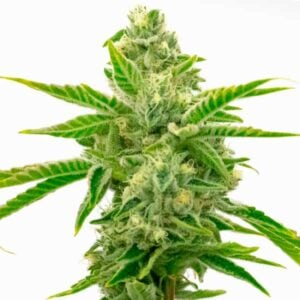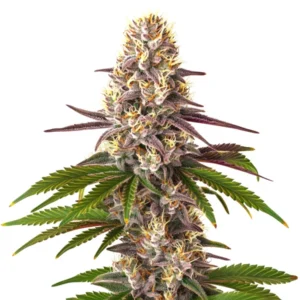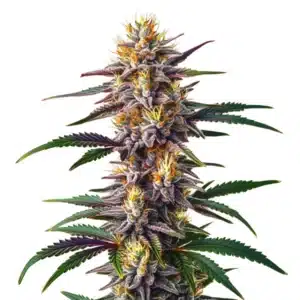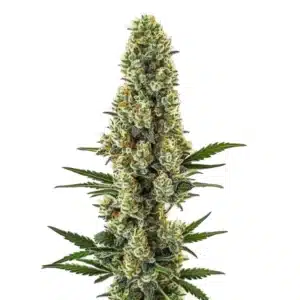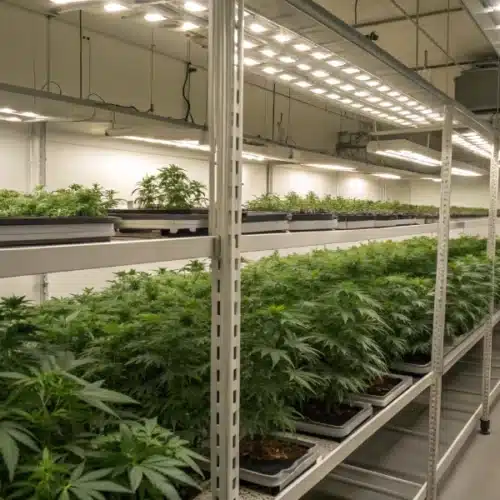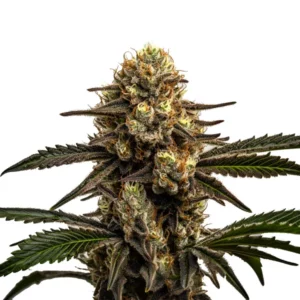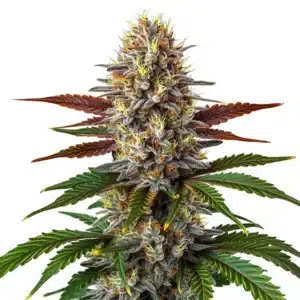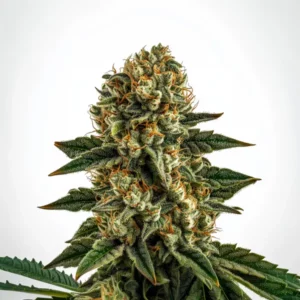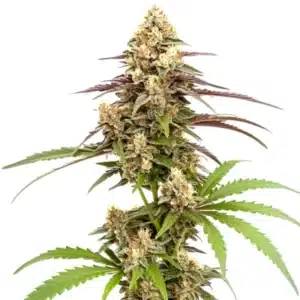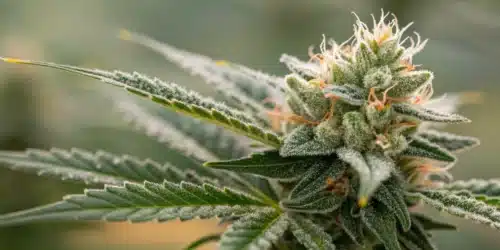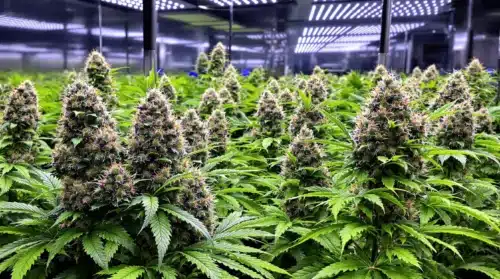Apple Fritter Seeds Description
Apple Fritter Weed Strain is a highly sought-after cannabis strain that has gained immense popularity among cannabis enthusiasts. Known for its unique combination of aroma, flavor, and effects, this strain has become a favorite among both recreational and medicinal users. For visual references, browse our apple fritter strain pictures.
Recommended Strains
Apple Fritter
 THC: 22% - 25%
THC: 22% - 25% Type of seed: Feminized
Type of seed: Feminized Phenotype: Mostly Indica
Phenotype: Mostly Indica Day to flower: 8 - 10 weeks
Day to flower: 8 - 10 weeks
Apple Fritter is a cross between two renowned strains, Sour Apple and Animal Cookies. The resulting hybrid offers a harmonious blend of Indica and Sativa characteristics. It typically features dense, tightly packed buds with a range of vibrant colors, including shades of green, purple, and orange. The buds are covered in a thick layer of trichomes, giving them a frosty appearance.
One of the distinguishing features of Apple Fritter Weed Strain is its complex aroma and flavor profile. It combines sweet and fruity notes with hints of apple, cinnamon, and spices. The combination of these flavors creates a truly delightful and memorable smoking experience.
Promos & Deals
Environmental Requirements for Growing Marijuana Apple Fritter Weed
Creating the ideal environment for your Apple Fritter Weed Strain plants is crucial to ensure their optimal growth and development. The environmental requirements of this strain will help you provide the best conditions for a successful cultivation process.
The Apple Fritter strain thrives in a temperate climate, where temperatures range between 70-80°F (21-27°C) during the day and slightly cooler temperatures at night. It is essential to maintain a stable temperature and humidity level within the grow space to prevent stress or potential issues such as mold or mildew.
When growing this Weed Strain indoors, providing adequate lighting is crucial. High-quality LED grow lights or HPS lamps are recommended to ensure proper photosynthesis and robust bud development. During the vegetative phase, provide a light cycle of 18-20 hours of light per day, and switch to 12 hours of light and 12 hours of uninterrupted darkness to initiate flowering.
For outdoor cultivation, choose a location with ample sunlight and a favorable climate. Apple Fritter Weed Strain thrives in a sunny and warm environment, allowing it to reach its full potential. If you live in a region with cooler climates, consider using a greenhouse or providing additional protection to extend the growing season and safeguard your plants from adverse weather conditions.
Setting Up The Growing Cannabis Space
Before you begin growing apple fritter strain, it is essential to set up an efficient and well-organized growing space. Whether you choose to cultivate indoors or outdoors, the following factors should be considered:
Indoor Cannabis Cultivation
For indoor growers, selecting the right grow tent or dedicated grow room is crucial. Ensure that the space provides sufficient room for the plants to grow vertically and has proper ventilation to maintain a fresh airflow. Install an efficient exhaust system with a carbon filter to control odors and prevent the accumulation of heat or humidity. Use reflective materials or Mylar sheets to maximize light distribution and avoid light leaks that could disrupt the flowering phase.
Choose a suitable growing medium for Apple Fritter, such as high-quality soil or a hydroponic system, depending on your preferences and experience. Ensure proper drainage to prevent waterlogging and maintain a balanced pH level of around 6.0-6.5 for optimal nutrient absorption.
Outdoor Cannabis Cultivation
When cultivating this strain outdoors, especially if you’re planning an apple fritter outdoor grow, select a location with plenty of sunlight and suitable soil conditions. Ensure the soil is well-draining and rich in organic matter. Consider using large containers or fabric pots to have better control over soil quality and root health. Additionally, protect your plants from strong winds by placing them near a fence or using windbreaks.
Using stakes or trellises to support the branches of your Apple Fritter marijuana plants is recommended. When growing an apple fritter strain plant outdoor, support is crucial to avoid branch breakage. This helps prevent the branches from bending or breaking under the weight of the dense buds and promotes better airflow.

Propagation and Germination of Marijuana Seeds Apple Fritter Seeds
Successful germination and propagation are essential for a strong and healthy apple fritter weed plant that will thrive in various conditions. Follow these steps to ensure a high germination rate and successful propagation:
1. Start by selecting high-quality Apple Fritter seeds from a reputable seed bank, like Blimburn Seeds. This ensures genetic stability and the feminization of your plants.
2. Begin the germination process by soaking the seeds in distilled water or a damp paper towel for 24-48 hours. Maintain a temperature between 70-85°F (21-29°C) and provide a dark and undisturbed environment.
3. After the seeds have soaked and developed taproots, transfer them carefully to a pre-moistened growing medium, such as a seedling tray or small pots filled with a light and well-draining soil mix.
4. Place the seeds in a warm and humid environment with gentle airflow. Maintain a temperature around 75-80°F (24-27°C) and a humidity level of 60-70% for optimal germination.
5. Provide indirect light to the seedlings during the first few days, gradually increasing the light intensity as they develop. Avoid exposing them to intense light or heat that could cause stress or damage.
6. Once the seedlings have developed a few sets of true leaves, they are ready to be transplanted into larger pots or the final growing containers.
By following these germination and propagation steps, you can ensure a successful start for this plants and establish a strong foundation for healthy growth and abundant yields.
Vegetative Phase of Cannabis seeds Apple Fritter Weed Strain
The vegetative phase is a crucial stage in the development of this plants. Here are some key considerations during this phase:
Lighting: Provide this plants with 18-20 hours of light per day to promote vigorous vegetative growth. High-quality LED grow lights or HPS lamps are recommended to ensure sufficient light intensity and spectral distribution.
Nutrition: During the vegetative phase, this plants require a balanced and nutrient-rich diet. Use a reputable cannabis fertilizer with a higher nitrogen (N) content to encourage healthy leaf and stem growth. Follow the manufacturer’s instructions and monitor the plants for any signs of nutrient deficiencies or excesses.
Watering: Water your plants when the top inch of the soil feels dry. Avoid overwatering, as it can lead to root rot and other moisture-related issues. Allow the soil to dry out slightly between watering sessions, but ensure the plants do not experience extreme drought.
Training: Consider employing training techniques such as low-stress training (LST) or topping to control the height and shape of your Apple Fritter Weed Strain plants. For more detailed cultivation records, refer to our apple fritter strain grow journal. These methods help create an even canopy, increase light penetration, and promote better bud development.
Pruning: Remove any lower branches or leaves that receive little light or show signs of disease or pests. This helps improve airflow and reduces the risk of mold or mildew formation.
By providing your Apple Fritter plants with the right environmental conditions, nutrition, and care during the vegetative phase, you can establish healthy and robust plants ready for the flowering stage.
Flowering Phase of Marijuana Seeds Apple Fritter Weed Strain
The flowering phase is the most anticipated stage of growing this strain, as it is when the plants develop their characteristic buds. Here’s what you need to know:
Lighting: Adjust the light cycle to 12 hours of light and 12 hours of uninterrupted darkness to initiate the flowering phase. Use a timer to maintain a consistent light schedule. During this stage, the plants require intense light, so ensure your grow lights provide adequate coverage and maintain the appropriate distance from the canopy.
Nutrition: Transition from a nutrient formula higher in nitrogen to a bloom or flowering-specific nutrient formula. These formulations are generally higher in phosphorus (P) and potassium (K), which promote bud development and overall flowering performance. Monitor the plants closely and adjust nutrient levels as needed to avoid deficiencies or toxicities.
Temperature and Humidity: Maintain a slightly lower temperature during the flowering phase, ideally around 65-75°F (18-24°C), to encourage resin production and prevent heat-related stress. As for humidity, aim for levels around 40-50% to minimize the risk of mold or bud rot.
Support: As your Apple Fritter Weed Strain plants enter the flowering phase, the weight of the developing buds may cause branches to bend or break. Provide adequate support using stakes or trellises to ensure the plants can bear the weight and avoid bud damage.
Flowering Time: This Weed Strain, with apple fritter strain flowering time insights, typically has a flowering time of 8-10 weeks, though this may vary depending on the specific phenotype and environmental conditions. Monitor the trichome development using a magnifying tool to determine the optimal harvest window.
Throughout the flowering phase, maintain a vigilant eye for any signs of pests or diseases. Implement proper pest management practices and take immediate action at the first sight of infestation or abnormalities.
Cannabis Fertilization and Nutrition – Apple Fritter Weed Strain
Proper nutrition and fertilization are crucial for maximizing the growth, yield, and overall health of this plants. Consider the following tips:
Choosing the Right Fertilizer: Select a high-quality cannabis-specific fertilizer or nutrient line that provides a balanced blend of macro and micronutrients. Look for products rich in nitrogen (N), phosphorus (P), and potassium (K) to support healthy growth, root development, and bud formation.
Feeding Schedule: Follow the manufacturer’s instructions and adjust the feeding schedule based on your plants’ specific needs. Start with a lower concentration and gradually increase it as the plants progress through their growth stages. Monitor the plants closely for any signs of nutrient deficiencies or excesses, and make adjustments accordingly.
Supplements and Additives: Consider incorporating supplements and additives into your feeding regimen to enhance specific aspects of plant development. These may include bloom boosters, beneficial microbes, enzymes, or organic amendments that improve soil structure and nutrient availability.
Regularly monitor your plants’ response to the feeding program, adjusting nutrient concentrations and frequencies as needed. Remember to flush the plants with pure water during the final weeks of the flowering phase to remove any excess salts or nutrients, which can affect the flavor and overall quality of the final harvest.
Pest And Disease Control for Cannabis Growing – Apple Fritter Weed Strain
Whilet his Strain is known for its resilience, it is still susceptible to pests and diseases. Implementing proper pest and disease control measures is crucial to protect your plants and ensure a successful cultivation. Here are some preventive and corrective actions:
Prevention:
- Regularly inspect your plants for any signs of pests, such as spider mites, aphids, or thrips. Early detection is key to preventing a full-blown infestation.
- Maintain a clean and tidy growing space, removing any dead plant material or debris that could harbor pests or pathogens.
- Introduce beneficial insects, such as ladybugs or predatory mites, to your garden to help control pests naturally.
- Ensure proper airflow and ventilation in the growing space to reduce the risk of mold or mildew formation.
- Quarantine new plants or clones for a period of time before introducing them to your main garden to prevent the spread of potential pests or diseases.
Corrective Measures:
- If you identify a pest infestation, consider using natural remedies like neem oil, insecticidal soap, or diatomaceous earth to combat the problem. Always follow the product instructions and apply treatments during the evening to minimize harm to beneficial insects.
- For more severe infestations, you may need to use chemical pesticides as a last resort. Be cautious when using chemical treatments and ensure they are safe for use on cannabis. Follow all safety precautions and adhere to recommended application rates.
- When dealing with fungal issues like powdery mildew or bud rot, remove and discard affected plant parts immediately to prevent further spread. Use a fungicide formulated for cannabis cultivation and maintain proper humidity levels to discourage fungal growth.
- Keep a close eye on your plants throughout their growth cycle and address any problems promptly. Regularly inspect both the upper and lower sides of leaves, as well as the buds and stems, to catch issues early.
Harvesting and Curing for Cannabis Growing – Apple Fritter Weed Strain
The harvesting and curing process significantly impacts the quality and potency of your Apple Fritter Weed Strain buds. Here’s how to go about it:
Harvesting:
- Harvest this plants when the trichomes have reached their desired level of maturity. Use a magnifying tool to examine the trichomes on the buds; they should appear cloudy or amber, indicating peak cannabinoid production.
- Use clean, sharp pruning shears to carefully trim the branches containing mature buds. Remove fan leaves and excess foliage to improve airflow during the drying process.
- Hang the trimmed branches in a cool, dark, and well-ventilated space to dry. Maintain a temperature of around 60-70°F (15-21°C) and a humidity level of 45-55% during the drying period, which typically lasts 7-14 days.
Curing:
- Once the buds have dried to the point where they snap when bent, transfer them to airtight glass jars or containers. Fill the containers about 2/3 full to leave some space for air circulation.
- Store the jars in a cool, dark place with a temperature of approximately 60-70°F (15-21°C) and a humidity level of 55-65%. Use hygrometers to monitor humidity levels and burp the jars daily during the first week to release excess moisture and prevent mold growth.
- Continue to burp the jars less frequently over the following weeks, gradually reducing the frequency until you only need to burp them every couple of weeks. The curing process can last anywhere from several weeks to several months, depending on your preferences.
- Proper curing enhances the flavor, aroma, and overall smoking experience of your Apple Fritter buds. Once cured, store your cannabis in a cool, dark place away from light and heat to maintain its quality.
Is Apple Fritter Weed an Indica or Sativa?
Apple Fritter is a hybrid cannabis strain that combines characteristics of both Indica and Sativa varieties. It offers a balanced and well-rounded experience, making it appealing to a wide range of cannabis users. Here are some of its key characteristics:
- Indica Influence: Apple Fritter’s Indica genetics contribute to its ability to relax the body, relieve stress, and induce a sense of calm and tranquility. It may also have analgesic properties, making it potentially beneficial for pain relief.
- Sativa Influence: The Sativa influence in Apple Fritter Weed Strain provides a euphoric and uplifting cerebral effect. It can enhance creativity, boost mood, and promote sociability. Users often report feeling happy and motivated after consuming this strain.
- Hybrid Balance: This Weed Strain’s hybrid nature ensures a balanced combination of both Indica and Sativa effects. The specific effects may vary depending on factors such as the plant’s phenotype, harvest timing, and individual tolerance.
Ultimately, whether you prefer the relaxing Indica effects, the invigorating Sativa effects, or a combination of both, Apple Fritter Weed Strain offers a versatile and enjoyable cannabis experience.
Advantages of Growing Apple Fritter Seeds
Growing Apple Fritter Weed Strain cannabis seeds comes with several advantages, making it a popular choice for cultivators:
- Unique Flavor and Aroma: Apple Fritter is renowned for its exceptional flavor profile, combining sweet, fruity, and spicy notes with hints of apple and cinnamon. The delightful taste and aroma make it a favorite among connoisseurs.
- Balanced Effects: With a balanced combination of Indica and Sativa effects, Apple Fritter Weed Strain offers a versatile experience that appeals to both recreational and medicinal users. It can provide relaxation, pain relief, mood enhancement, and creativity stimulation.
- High Potency: Apple Fritter Weed Strain is known for its high THC content, which can range from 20% to 30% or more. This potency ensures a potent and long-lasting experience for those seeking intense effects.
- Resilient Growth: Apple Fritter Weed Strain plants are known for their resilience and adaptability, and they offer an impressive apple fritter strain yield, making them suitable for various growing environments They can thrive indoors, outdoors, or in greenhouses.
- Appealing Appearance: The vibrant colors and frosty trichomes of Apple Fritter Weed Strain buds make them visually striking and aesthetically pleasing.
Disadvantages of Growing Apple Fritter Weed Strain Cannabis Seeds
While there are many advantages to growing Apple Fritter Weed Strain cannabis seeds, there are also some potential disadvantages to consider:
- High THC Content: The high THC content of Apple Fritter Weed Strain can be overwhelming for novice users or those with low tolerance. It may lead to anxiety, paranoia, or other adverse effects in sensitive individuals.
- Odor Control: Apple Fritter Weed Strain has a strong and distinctive aroma that can be challenging to manage, especially when growing indoors. Effective odor control measures, such as carbon filters and exhaust systems, may be necessary.
- Space Requirements: Apple Fritter Weed Strain plants can grow tall and bushy, requiring ample vertical and horizontal space. Ensure you have enough room in your growing area to accommodate their growth.
- Legal Considerations: The cultivation and use of cannabis are subject to legal restrictions and regulations in many regions. Check your local laws and regulations before growing Apple Fritter Weed Strain or any cannabis strain.
Overall, growing Apple Fritter cannabis seeds can be a rewarding experience for those who appreciate its unique qualities and are prepared to address its potential challenges.
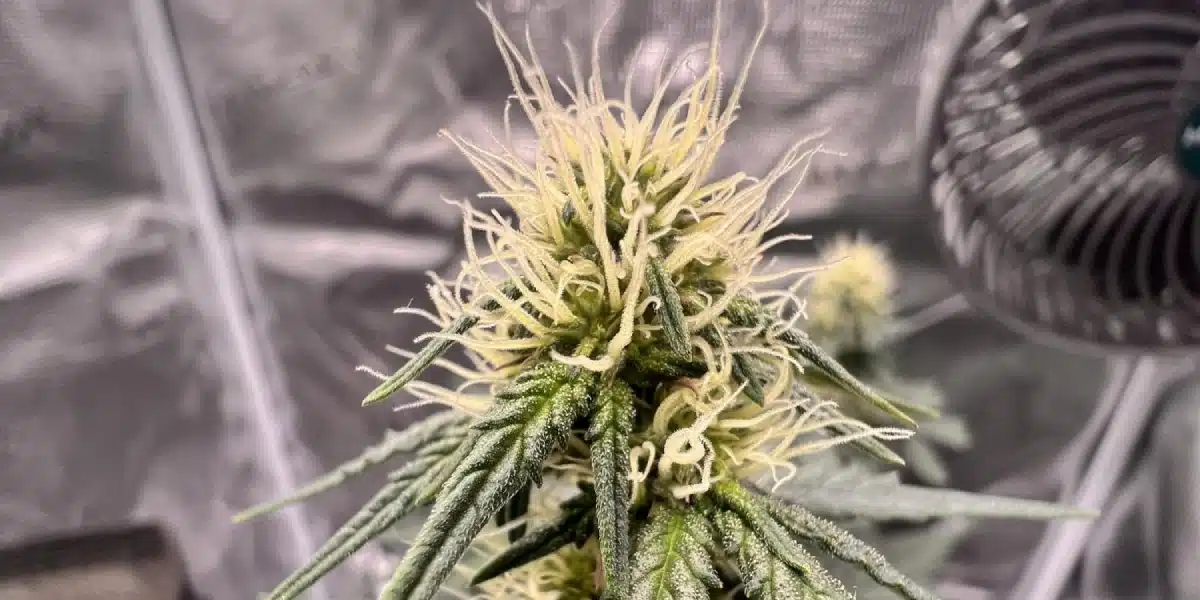
FAQS about Apple Fritter Weed Strain
What is the ideal environment for growing Apple Fritter Weed Strain?
Apple Fritter Weed Strain thrives in a temperate climate with daytime temperatures between 70°F and 80°F and slightly cooler nights. Ensure stable humidity levels and proper ventilation to prevent mold or mildew. Use high-quality LED grow lights indoors and select a sunny, warm location for outdoor cultivation. Consistent conditions promote healthy growth, robust bud development, and optimal resin production throughout the plant’s lifecycle every season.
How long is the flowering time for Apple Fritter Weed Strain?
The flowering phase for Apple Fritter Weed Strain typically lasts between eight to ten weeks, depending on environmental conditions and specific phenotype variations. Growers should monitor trichome development closely using a magnification tool to determine optimal harvest timing. Consistent lighting and proper nutrient adjustments are essential during this period to maximize bud quality and potency, ensuring a balanced, high-quality yield throughout the flowering stage consistently.
What are the key nutrient requirements for Apple Fritter Weed Strain?
Apple Fritter Weed Strain requires a balanced nutrient regimen for cannabis growth. During the vegetative stage, higher nitrogen levels support vigorous leaf development, while phosphorus and potassium become essential during flowering to boost bud formation. Use quality fertilizers and monitor pH levels between 6.0 and 6.5. Adjust feeding based on plant response and environment to ensure steady growth and maximize yield for optimal final performance.


